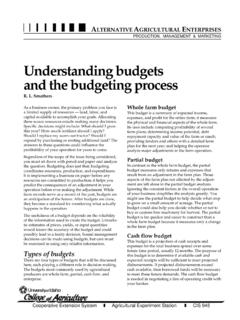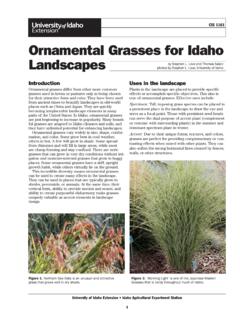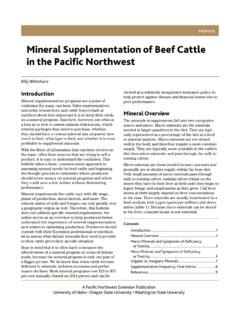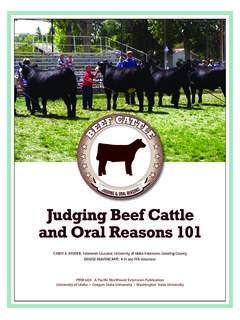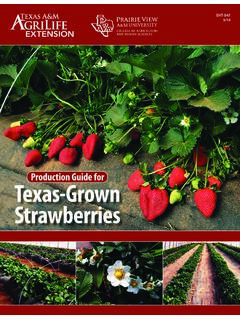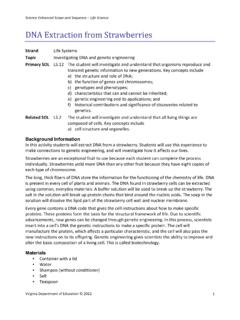Transcription of Growing - University of Idaho
1 Growingin the Inland Northwest&Intermountain Westby Danny L. BarneyStrawberriesThe authorDanny L. Barney, Extension Horticulture Specialist andSuperintendent of the University of Idaho s SandpointResearch & Extension Center. 1999 University of IdahoContentsSelecting a site .. 1 Preparing your site .. 3 Selecting cultivars .. 4 Planting, training, and first-year care .. 8 Planting .. 8 Training .. 10 First-year care .. 11 Yearly care .. 11 Irrigation and fertilization .. 11 Weed control .. 13 Managing pests and diseases .. 14 Pests .. 14 Diseases .. 18 Harvesting and storingyour strawberries .. 22 Renovating June-bearing strawberries .. 23 Protecting strawberry plants in winter .. 24 Here is a crop beautifully suitedto the Inland Northwest and well into Idaho sbordering regions in Montana, Wyoming, and , one of the most adaptable fruit cropsin the world, are grown from the tropics to near the ArcticCircle.
2 Perennial favorites of home gardeners, they are alsogrown for local commercial sales throughout the InlandNorthwest and Intermountain West. Besides their popular-ity as fresh fruits, strawberries are used to create pastries,jams, syrups, compotes, fruit leathers, and other are among the easiest fruits to raise. For homeproduction, strawberries are often grown in raised beds,pyramids, decorative pots, and hanging baskets. Commer-cially, strawberries are grown in flat or raised beds, often inrotation with vegetable crops. strawberries are an excellentspecialty crop for local markets. For more information onthe commercial potential for locally-grown strawberries ,refer to the readings list at the end of this a siteAlthough strawberries are highly adaptable, good siteselection is critical. strawberries require full sun for consis-tent production of high-quality strawberry cultivars (cultivated varieties) are suscep-tible to Verticillium wilt.
3 This fungal disease can persist inthe soil for many years, even in the absence of susceptiblehosts. Verticillium is common on potatoes, tomatoes,Strawberriesin the Inland Northwest & Intermountain West1eggplants, raspberries, blackberries, currants, gooseberries,cherries and other stone fruits, and chrysanthemums. Ifpossible, avoid planting strawberries where these crops havebeen grown within the past five years, and select strawberrycultivars that are resistant to Verticillium and other sodded areas can be infested with grubsthat damage strawberries . When planting into an area thathas been sodded, cultivate the planting area and grow arotation or green manure crop other than grass for one yearbefore planting require full sunfor consistent production ofhigh-quality are adaptable to a wide range of soil perform best on well drained, sandy loams at least 12inches deep, but most loam soils provide good results ifdrainage is adequate.
4 Heavy soils encourage the develop-ment of root diseases. strawberries are shallow-rooted, withmost of the roots in the top 12 inches of soil. Cultivarsused for fruit production do not tolerate droughty soilswithout ample irrigation. Soils with pH values between provide the best way to ensure soil drainage and reduce frost problemsis to plant on a site that lies above surrounding sites with slopes of about 2 percent providedrainage without greatly increasing soil beds or ridges will improve soil drainage on flatsites. Raised beds can be as simple as mounds of soil or maybe enclosed in untreated landscape timbers or stones in anornamental setting. For home production, raised bedsallow you to customize the soil with compost, peat moss,2sand, or other amendments (fig. 1). Raised beds warm upand dry out quickly in the spring, giving an early start onthe season.
5 Tractor-mounted implements are used to createplanting ridges for commercial fields (fig. 2).Preparing your siteEliminating weeds before planting strawberries is criticallyimportant because eradicating weeds in an establishedstrawberry bed is very difficult. Quackgrass and otherperennial weeds that spread by underground stems (rhi-zomes) are highly invasive and are the most serious weedsin strawberries . Growing rotation or green manure cropsand mechanically cultivating the soil before plantingstrawberries are standard weed control practices. Perennialweeds can also be killed before planting strawberries byapplying a translocatable herbicide, such as glyphosate,which kills both weed tops and two-level raised bed for Growing strawberriesin a home garden. The two-level system increases lightexposure compared with single-level beds and makesmanaging the rows feet4 feetUntreatedlandscape timbersPest control is another important preplanting consider-ation, particularly in a previously sodded site.
6 Some grow-ers incorporate insecticides into soils where sod worms havebeen a problem. Always follow label directions whenapplying herbicides and other cultivarsChoosing strawberry cultivars adapted to your Growing areais important in creating a healthy and productive sure your selections are cold hardy in your strawberry cultivars can tolerate winter temperaturesnear -50oF, while others are killed at temperatures slightlybelow are three types of strawberries : June-bearing, double-cropping everbearing, and dayneutral. Table 1 lists recom-mended strawberry These are among the most productive andpopular strawberries . They form flower buds in the fall andbear one heavy crop the next spring or early summer. Theberries ripen over about three weeks, with the earliestberries being the largest. Some cultivars begin ripeningthree weeks earlier than others.
7 June-bearing cultivarsinclude Benton, Honeyoye, Totem, and many everbearers. Everbearers set flower budsduring the short days of autumn and again during the longdays of midsummer. Consequently, they bear two cropseach season, during the spring and late summer. Typically,they produce a few fruits between the main are popular because fruit production is spreadout over time. Yields, however, are lower than for June-bearing or dayneutral cultivars. Ft. Laramie and Quinaultare popular everbearers. Ozark Beauty was once popular,but is being replaced by the better-quality Tristar andTribute dayneutral to 18 inches18 to 24 inches10 inches4 to 9inches18 inches9 to 18 inchesMother plantsDaughter plants(up to 6 per mother plant)Runners12 to 18inchesFigure planting ridgeMatted rowRibbon row5 June-bearersExpected yield: to pound per foot of rowduring the second and third Growing seasonsFruiting year: SecondSpacing:Matted row: 12 to 18 inches apartin rows 36 to 48 inches apartRibbon row: 4 to 9 inches apartin rows 36 inches apartDouble-cropping everbearersExpected yield: to pound per foot of rowduring the second and third Growing seasonsFruiting year: SecondSpacing:Matted row: 12 to 18 inches apartin rows 36 to 48 inches apartRibbon row.
8 4 to 9 inches apartin rows 36 inches apartDayneutralsExpected yieldYear 1 to pound per foot of rowYears 2-3 to pounds per foot of rowFruiting year: FirstSpacing:Matted row: 9 inches apartin rows 36 to 48 inches apartRibbon row: 4 to 9 inches apartin rows 36 inches apart6 Characteristics and requirementsfor strawberriesTable strawberry cultivars for the Inland Northwest andIntermountain characteristicsDisease resistanceRipeningDessertFreezingLeafLea fRed VerticilliumCultivar1 Use2date 3 Size4 Firmnessquality5quality5scorch6spot6stel e6wilt6 June-bearersEarliglowAll0 SFirmEEGPGGL esterHG6 LFirmEFGGGGH oneoye*All6 LFirmGGGGPPC atskillHG7 LSoftGFGPPES urecropAll7 LFirmGGFFGEC avendish*All7 VLMediumGGFFGFR edchiefPYO7 LFirmEGGGGGS cottAll8 LFirmEEGFGFA llstarAll8 VLFirmEGGGEGG uardianAll9 LFirmGFGFGGL ateglowAll9 LFirmEEGPGGT otem All9LV.
9 FirmGGUUFFG looscapAll10 LFirmGEGGPFM icmacAll10M-LFirmGGGGPPB entonAll10 MMediumFGUUUGJ ewelAll10LV. FirmEEGGPPB lomidonAll12 LFirmGEGGPUS huksanAll12 VLFirmGEFPFFD ayneutralsTristarAll2 MFirmEGGPGGT ributeAll7M-LV. FirmEGGGEED ouble-cropping everbearersFort Laramie* HG4 LMediumEGUUUUQ uinault HG7 MSoftGFGGGU_____1* = Especially cold hardy2 All = Suitable for commercial production, U-pick, or home gardensPYO = Suitable for U-pick or home gardensHG = Best suited to home gardens3 Approximate number of days after Earliglow ripens4 Size: S = small; M = medium; L = large; VL = very large5 Dessert and freezing quality: P = poor; F = fair; G = good; E = excellent6 Disease resistance: P = poor; F = fair; G = good; E = excellent; U = unknown7 Dayneutrals. These cultivars set flower buds regardless ofday length and bear fruit from spring through fall.
10 In manyareas, dayneutrals crop similarly to everbearers, with twomain crops each year and a trickle of berries in develop few runners, so they are often plantedin ribbon rows. Tristar and Tribute are popular with north-ern growers. Selva, Fern, Seascape, and Hecker aredayneutral cultivars that are popular in other areas of thecountry, but their hardiness and productivity in the InlandNorthwest and Intermountain West are largely , training,and first-year carePlantingWhile it is easy to produce and transplant your own straw-berry runner plants, the practice is not always cost and diseases can quickly build up in home andcommercial plantings. For best results, buy nursery-grownplants. Consider buying stock certified as virus-indexed,which can yield 50 to 75 percent more fruit than virus-infected strawberries to the correct firming the soil, and watering the plants,the soil level should be halfway between theroots and the top of the deepToo shallowCorrectplanting depthDormant strawberry plants (sometimes called crowns) areusually sold bare root in bundles of 25.
